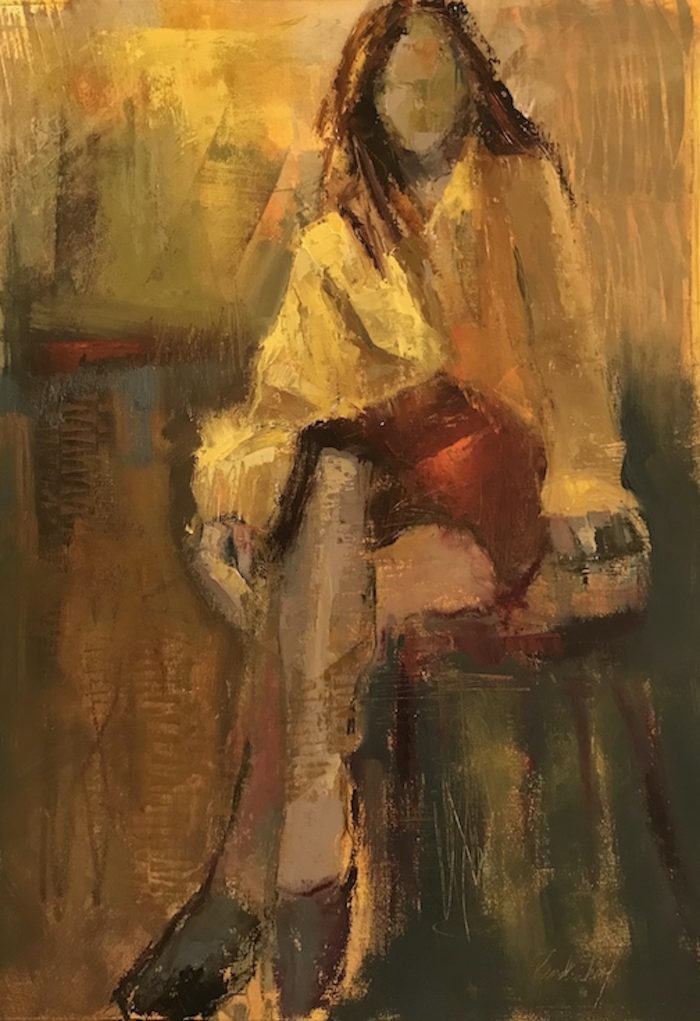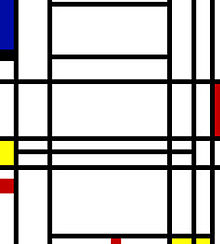Journey of a Thousand Miles

I am taking a break from Facebook. I am also remodeling my kitchen. And I am 68 years old. What do all these things have in common? Well things inevitably change. What used to work for me is not working for me anymore. I love "most" of the people I follow on Facebook, but I realized that it was not a great use of my time, especially when I am remodeling my kitchen. Time is valuable and it is more evident as I get older.
I have walked at least a thousand miles and yet where have I ended up? Have I become all that I want to be at 68 years old? Has my art been a success? All these are good questions. I don't want to be walking aimlessly, but to have goals and desires that pull me and fill me.
My life has become too serious and I almost forgotten how to play. Can you enjoy, have fun and still be productive and successful? Playing has taken me on a new journey with my subject matter. My new journey as an artist is creating abstract art using the female figure. I am focusing on one thing; women in all sizes and shapes. Using stencils, mixed media, charcoal, oil pastel, pallet knives, large brushes, and painting on Arches oil paper, has resulted in the most surprising and interesting textures that can only be appreciated in person. And in the process I am having fun.
From now on this is my requirement for doing my art. I must have fun and enjoy, otherwise it becomes drudgery for me. Using the tools above opened my eyes to successfully creating and satisfying the child in me at the same time.
"Chances" is the name of the painting above. It measures 18" x 26", available for purchase. The first statement is an entire abstract painting, next a figure drawn in charcoal then layered with oil paint using larger brushes and pallet knife. I used a roller, as well, to loosen up the work and create soft edges. Scraping and stencils under and over the figure were also used to create interest.
Please contact me if you are interested in purchasing or have any questions in regards to "Chances". I also would love hearing from you and any comments you may have on your journey.
I hope you enjoy this new way of my creating. Thank you for your time!
Cold Wax Part II Tools and Applications
Exploration is really the essence of the human spirit.~Frank Borman
This is part two of my Cold Wax post covering tools and applications. Please read part one before continuing if you haven't done so. We've talked about the supports and types of wax in my previous post. Essentially, it is best to use a harder support if you want to use thicker layers of wax. Below are the lists of tools and mediums used with CWM.
Tools for applying the wax: Brayers (2",4" & 6" Speedball and Inovart ), brushes (all sizes, all types), Princeton Catalyst Blades, pallet knives, Princeton Catalyst Silicone Wedge, Dough Scraper by Wilton
Tools for drawing: Charcoal, Graphite stick (preferably soft), oil sticks, oil bars, bamboo skewer, stencils, doily, Q-tips, oil pastels, beeswax crayons, knitting needles, pottery scraper, pottery carving tool, oil pen, stamps, the above Princeton Catalyst Blades and Wedges can also be used for marking.
Tools for creating texture: Rubber basting brush, steel wool, yarn or string, plastic combs, pattern tracers, plastic wrap, bubble wrap, whisk broom, muslin, florist mesh, cheese cloth
Mediums: Following to thicken CW-Marble dust, lime, coffee, dirt, graphite powder, Gilder paste, sand; Citra Solve and Gamsol to remove layers of wax, Gamblin Solvent free Gel, Solvent free fluid and Liquin to thin mixture or glaze.
Application: Prior to putting down the first layer of CWM, prime your support with a solid color of oil paint of your choice. Let the it dry throughly before laying down layers of CWM. Take a large sheet of Reynolds Freezer Paper, tape it to a flat surface. This will be your pallet. Lay out your pallet of oil paint, take a dollop of oil paint and mix with pallet knife 30 to 50% of CWM. Then take your brayer and roll into mixture on Freezer Paper. Roll the mixture on primed support. Take another color and do the same, etc. You can lay wet into wet if you have a light touch. You can dry in between layers.
It is advised that you work on more than one painting at a time to allow for drying time. You will have different drying times for different colors of oil paint.
You can then build up by layering with larger amounts by applying it with pallet knife, squeegee, wedge etc. As the wax dries, you can start to scrape, revealing the layers below, or you can use any of your drawing tools. Drawing is much easier if the layers are somewhat dry. It is easier to mark when it is tacky and not completely dry.
There isn't one way to use CWM. I noticed through my research that each artist creates their own style. Some artist may create abstracts, while other may create landscapes, still life or figures. Some artists may prefer the squeegee, wedge, scraper or pallet knife to apply the cold wax and oil paint mixture rather than the roller or a combination of both.
Experiment and have fun, discover your own way with CWM.
Below are a couple of videos using Cold Wax Medium.
https://youtu.be/mc0NvgyLm_E
https://youtu.be/M4nwjauyMZc
Does A Painting Always Need A Focal Point?

Is the use of a focal point in a painting discretionary? It has been argued that a painting doesn’t have the strength of composition without one. I am taking an online art course that includes the topic of focal points. The viewpoint taught is that all paintings must have one. It is in doing this course that has caused me to question, whether it is necessary or not. In the painting above, I have forced myself to create a focal point. In most cases, my paintings don’t have one. I prefer to have the viewer move around the canvas, explore and experience and not be inclined to stay in one area of the painting.
Let’s examine how a focal point is created.
- Placement: The eye is drawn to the center and front of the painting, yet finding an appealing location for the focal point is important. “Where do you want the viewers eye to go?”
- Contrast: The eye is attracted to the brightest area and the darkest dark next to the lightest light.
- Color: The viewer is also attracted to the brightest most vivid color, which can be intensified by the use of complimentary colors next to each other.
- Shape: A unique shape, a larger shape or an extremely active shape may suggest a focal point.
- Line direction and converging lines: Lines may direct your eye to the focal point by using architecture, calligraphy and intersecting lines. Anything can point to a focal point.
- Isolation: Separating subject from distracting elements can strengthen focal point.
- Focus: Anything that is more focused, defined, with sharp edges instead of blurred will strengthen focal point.
There are many famous artists that don’t use focal points in their paintings. Monet chose to capture an impression of the effects of light and color, as opposed to focusing on one patch of water lilies in this painting.

Hans Hoffman’s desire was to create an illusion of space, forcing the eye to move along the two-dimensional plane using color, shape and line.

Piet Mondrian’s grid paintings simplified his compositions to primary colors, white, and black lines intersecting vertically and horizontally focusing on the positive and negative shapes.

Learning the rules of good composition is important, but in the end you must make a decision for yourself.
What do you think? Does a painting have to have a focal point?
Hong Kong Clay Pot, oil on museum wrapped canvas, 48" x 48" Price $5760
2k14 current footage 2304 sq. inches
*All art from Janet Vanderhoof’s Fine Art Gallery, maybe seen in Janet’s studio at Morgan Hill, CA. You may purchase through contacting my email jvander51@msn.com or phone (408) 460-7237. Thank you!
Environment Friend or Foe

A friend of famous artist S. C. Yuan, Walter Georis, describes Yuan’s painting habits, “I remember that he was constantly trying to break some rules. He felt it necessary, In order to be a little bit mad at painting or bitter. He needed to be somewhat bitter in order to create the excitement or the stimulus that sometimes the city offers, that Carmel didn’t offer.”
Living in Morgan Hill, although driving distance to San Francisco, definitely is quieter than most, a typical bedroom community. I have become a contemplative living in the solitude of the country, and completely understand what S.C. Yuan was trying to do.
I believe as Oprah would say, that I am having an ah ha moment. I believe living in a small town has also influenced my style. I find a need to create a problem that needs to be solved every time I paint; such as using unusual pallets, have contrasting under-painting, try difficult compositions, use brushes that are large relative to the canvas and attempt subject matter that I am unfamiliar with.
Is this how I create more passion, more creative energy?
How important is where you live for an artist? Does it affect your art positively or negatively? Do artists that live in the country normally paint landscapes? Are abstract painters mostly found in the cities? Where do you live and how has your environment affected your art?
This is my fortieth painting of my #paint52 challenge, medium Atelier Interactive Acrylic on vellum, measures 10" x 12" price $300 plus Shipping and Handling.
*All art from Janet Vanderhoof’s Fine Art Gallery, maybe seen in Janet’s studio at Morgan Hill, CA. You may purchase through contacting my email jvander51@msn.com or phone (408) 460-7237. Thank you!
One Glass At A Time #paint52
This is my fifth painting of the #paint52 challenge and also another addition to my San Francisco Series. It measures 8" X 11" painted with Atelier Interactive Acrylics on velum. How appropriate it is called "One Glass At A Time", echoing my one painting at a time to complete 52 paintings in one year. I first painted a bright green underpainting and I used the Binder Medium to make sure it stayed put. The Binder Medium prevents the paint from bleeding through or being picked up when painting over it. I wanted to make sure that bits and piece showed through, since the color theme of the painting is a silvery pinkish color; it allowed the neutrals to vibrate. It also created a sensation for me while painting, a push pull effect, a term used by Hans Hoffman. I used mostly neutrals in this painting. I made a pile of half dark and half-light, and added my colors to these neutrals to create a pearlescent quality. I'm still getting used to using acrlyics, and love that I can paint quickly, creating a much looser painting. This is a desire of mine to paint loose, less is more. THIS PAINTING IS SOLD
Thank you for following me on my #paint52 journey!






